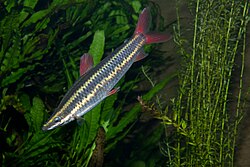| Anostomus anostomus | |
|---|---|
 | |
| Scientific classification | |
| Kingdom: | Animalia |
| Phylum: | Chordata |
| Class: | Actinopterygii |
| Order: | Characiformes |
| Family: | Anostomidae |
| Genus: | Anostomus |
| Species: | A. anostomus |
| Binomial name | |
| Anostomus anostomus | |
| Synonyms [2] | |

Anostomus anostomus, also known as the striped headstander , striped anostomus, and striped anastomus, [3] is a species of freshwater ray-finned fish belonging to the family Anostomidae, the toothed headstanders. [4] [3]
